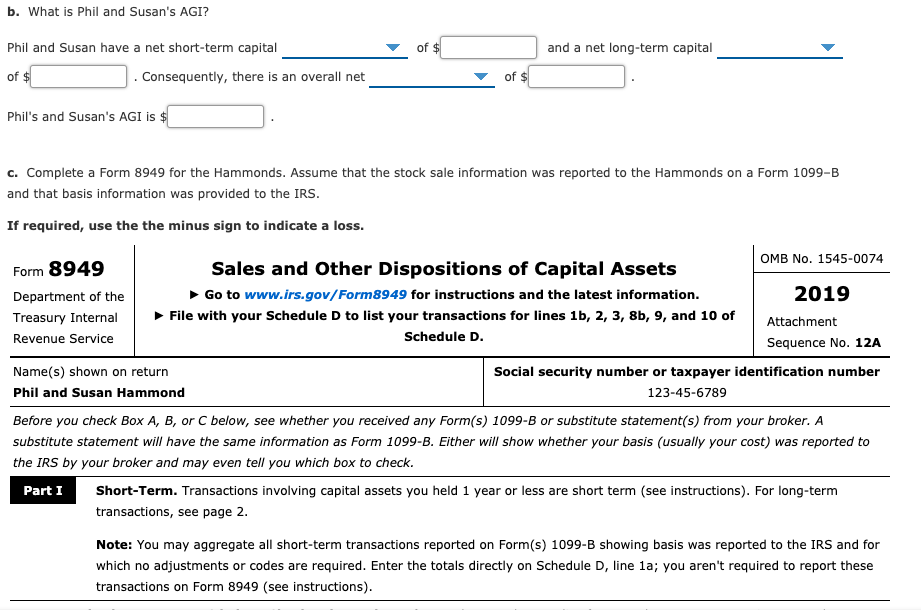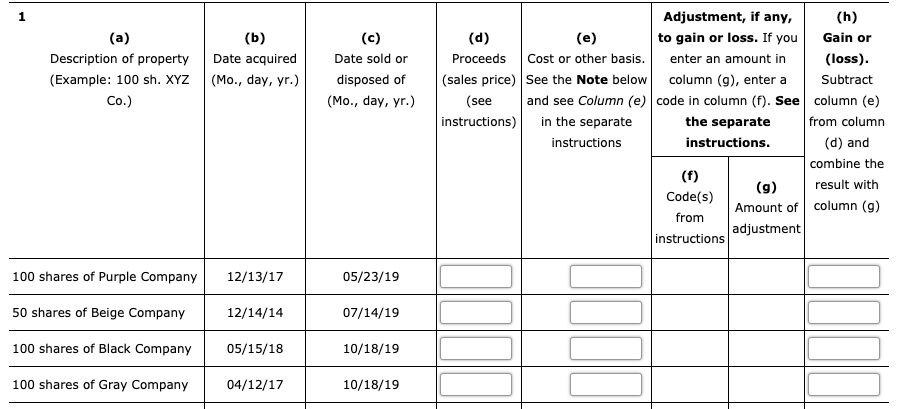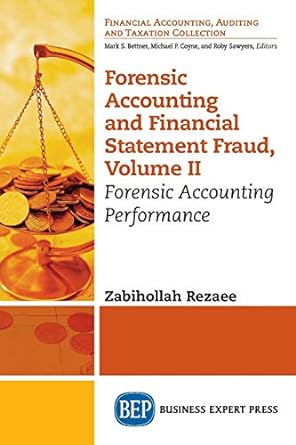



Phil and Susan Hammond are married taxpayers filing a joint return. The couple have two dependent children. Susan Hammond has wages of $34,000 in 2019. Phil does not work due to a disability, but he is a buyer and seller of stocks. He generally buys and holds for long-term gain, but occasionally gets in and out of a stock quickly. The couple's 2019 stock transactions are detailed below. In addition, they have $2,300 of qualifying dividends. Date Sold Cost Sales Price 03/12/19 $3,000 $6,000 05/23/19 36,000 32,000 Date Item Acquired Blue stock (10 shares) 11/10/18 Purple stock (100 shares) 12/13/17 Beige stock (50 shares) 12/14/14 Red stock (100 shares) 06/29/18 Black stock (100 shares) 05/15/18 Gray stock (100 shares) 04/12/17 07/14/19 13,000 14,500 05/18/19 26,000 27,000 10/18/19 67,000 89,000 67,800 88,200 10/18/19 a. Determine the nature and amount of the gain or loss for each of the stock transactions. Item Type of Gain or Loss Amount Blue stock Purple stock Beige stock Red stock Black stock Gray stock b. What is Phil and Susan's AGI? of $ and a net long-term capital Phil and Susan have a net short-term capital of $ Consequently, there is an overall net of $ Phills and Susan's AGI is $ c. Complete a Form 8949 for the Hammonds. Assume that the stock sale information was reported to the Hammonds on a Form 1099-B and that basis information was provided to the IRS. If required, use the the minus sign to indicate a loss. OMB No. 1545-0074 Form 8949 Sales and Other Dispositions of Capital Assets Department of the Go to www.irs.gov/Form8949 for instructions and the latest information. 2019 Treasury Internal File with your Schedule D to list your transactions for lines 1b, 2, 3, 8b, 9, and 10 of Attachment Revenue Service Schedule D. Sequence No. 12A Name(s) shown on return Social security number or taxpayer identification number Phil and Susan Hammond 123-45-6789 Before you check Box A, B, or C below, see whether you received any Form(s) 1099-B or substitute statement(s) from your broker. A substitute statement will have the same information as Form 1099-B. Either will show whether your basis (usually your cost) was reported to the IRS by your broker and may even tell you which box to check. Part I Short-Term. Transactions involving capital assets you held 1 year or less are short term (see instructions). For long-term transactions, see page 2. Note: You may aggregate all short-term transactions reported on Form(s) 1099-B showing basis was reported to the IRS and for which no adjustments or codes are required. Enter the totals directly on Schedule D, line 1a; you aren't required to report these transactions on Form 8949 (see instructions). 1 You must check Box A, B, or C below. Check only one box. If more than one box applies for your short-term transactions, complete a separate Form 8949, page 1, for each applicable box. If you have more short-term transactions than will fit on this page for one or more of the boxes, complete as many forms with the same box checked as you need. (A) Short-term transactions reported on Form(s) 1099-B showing basis was reported to the IRS (see Note above) (B) Short-term transactions reported on Form(s) 1099-B showing basis wasn't reported to the IRS (C) Short-term transactions not reported to you on Form 1099-B Adjustment, if any, to (h) (a) (c) (d) (e) gain or loss. If you enter Gain or loss). Description of property Date acquired Date sold or Proceeds Cost or other an amount in column (9), Subtract column (Example: 100 sh. XYZ (Mo., day, yr.) disposed of (sales price) basis. See the enter a code in column (f). (e) from column Co.) (Mo., day, yr.) (see Note below and See the separate (d) and combine instructions) see Column (e) instructions. the result with in the separate (f) (9) column (9) instructions Code(s) from Amount of instructions adjustment (b) 10 shares of Blue Company 11/10/18 03/12/19 100 shares of Red Company 06/29/18 05/18/19 1 (a) Description of property (Example: 100 sh.XYZ Co.) (b) Date acquired (Mo., day, yr.) (c) Date sold or disposed of (Mo., day, yr.) Adjustment, if any, (h) (d) (e) to gain or loss. If you Gain or Proceeds Cost or other basis. enter an amount in (loss). (sales price) See the Note below column (9), enter a Subtract (see and see Column (e) code in column (f). See column (e) instructions) in the separate the separate from column instructions instructions. (d) and combine the Code(s) result with (9) Amount of column (9) from adjustment instructions 100 shares of Purple Company 12/13/17 05/23/19 50 shares of Beige Company 12/14/14 07/14/19 LOUD 100 shares of Black Company 05/15/18 10/18/19 100 shares of Gray Company 04/12/17 10/18/19










